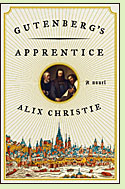Gutenberg's Apprentice
by Alix Christie
Reviewed by Margaret Tomlinson

Peter Schoeffer, the apprentice in Gutenberg's Apprentice, may have played as important a role in developing the printing press as Gutenberg. Peter's uncle, Johann Fust, financed Gutenberg's printing workshop and seems to have arranged Peter's position so he could report back on Gutenberg's progress and expenditures. The novel portrays a reluctant Peter Schoeffer leaving his work as a scribe in Paris to work under a hot-tempered, self-centered, secretive genius, and make his own crucial contribution to the artistry and success of the world's first printed Bible.
The research behind the novel is impressively thorough but never interrupts the story. Rather, it recreates the the mid-fifteenth-century German city of Mainz, a place torn by conflict between its city council, sympathetic to the working classes, and the church, biased toward the wealthy and armed with the weapon of excommunication. As a scribe proud of his skill, Peter is at first horrified by the concept of printing. The technique's mixed potential becomes ever more clear as the novel progresses. In the right hands, printing could standardize important texts and bring them into a price range that would allow many more people to own and read them. In the wrong hands, it could mass-produce exploitative writings like indulgences, the church-issued certificates purporting to speed a soul's path to heaven for a price, fundraisers for the pet projects of popes and archbishops.
Gutenberg's Bible was a massive project. Many snags along the way could have sunk it and bankrupted both Fust and Gutenberg. Though it held out the prospect of producing a hundred or more Bibles in about the time it would take a scribe to hand-write one, it was still time-consuming to produce the type, set it by hand, and print one folio sheet at a time. That offers plenty of suspense as the characters in Gutenberg's Apprentice struggle against the odds to produce their book before the secret of printing leaks out. (2014; 405 pages, including an Afterword about the characters' lives after the end of the novel)
More about Gutenberg's Apprentice at Powell's Books or Amazon.comOther novels about printers:
Hunters in the Snow by Daisy Hildyard (2013), about a woman of the present who discovers an unusual history of England written by her dead grandfather, beginning with the invention of the printing press in 1436. More info
The Floating Book by Michelle Lovric (2004), about a German printer, a promiscuous Jewish woman, and a variety of other characters in fifteenth-century Venice. More info
London in Chains by Gillian Bradshaw (2009), about a young woman who goes to work in London for a publisher of political pamphlets during the English Civil War. More info
Nonfiction about Gutenberg and the development of the printing press:
The Gutenberg Revolution by John Man (2002). More info
The Gutenberg Bible by Martin Davies (1996). More info
Gutenberg by Leonard Everett Fisher (1993). More info
Online:
The Gutenberg Bible, about the copy owned by the University of Texas at Austin, with pages viewable online.
Back to Medieval Europe: Fourteenth-Fifteenth Centuries
Back to Directory of Book Reviews